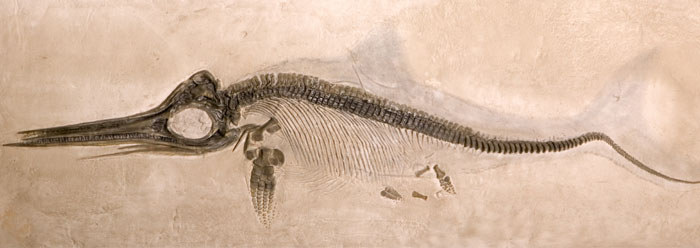The evolutionary history of certain extinct marine reptiles just got rewritten.
After rapidly evolving an array of variations, one particular variety of the dolphin-shape marine reptiles known as ichthyosaurs supposedly died out completely in extinction events dispersed over millions of years. But the recent description of out-of-place ichthyosaur fossils shows that this conception is wrong, and additional related clues point to even deeper problems.
A team of paleontologists examined ichthyosaur bone fossils from England and Germany, identifying a particular species in Cretaceous rocks.1 They didn't expect this, since other researchers had described similar-looking fossils farther below, in middle Jurassic rocks. The newly described ichthyosaurs were supposedly deposited some 60 million years later, having presumably lived through earlier catastrophic extinctions.
Ulrich Joger, a German paleontologist and one of the co-authors of the study published online in PLoS ONE, told BBC News, "It's a spectacular find. It raises new questions about the [Jurassic] (sic) extinction theory."2
One such question is why so many other animals apparently became extinct while this variety of ichthyosaurs survived. But this is only a problem if one assumes that the rock layers in question are separated by millions of years and punctuated by separate extinction events.
Perhaps, instead, the local fossil-bearing rocks in England and Germany were deposited in rapid succession by tsunami-like waves associated with a global catastrophe, burying various groups of creatures in a sequence of quickly formed strata. This scenario needs no imaginative add-ons to explain why only certain species survived for "millions" of years longer than others, since the dogma of vast time doesn't encumber it.
And the global flood scenario has the added benefit of explaining why there are ichthyosaur fossils at all. Only a powerful catastrophe can cover swift and strong-swimming animals quickly enough to completely bury them and prevent them from natural rapid decay.
The researchers examined ichthyosaur fossils taken from the Cambridge Greensand Formation in England. This rock layer also has ankylosaur dinosaurs, duckbill dinosaur teeth, extinct diving birds,3 flying reptiles,4 tiny crustaceans, clams,5 and ammonites.6
In 2011, workers learned of ankylosaurs, ichthyosaurs, clams, and ammonites packed in a Canadian sandstone.7 Those creatures originally lived nowhere near one another. What could have buried such diverse fauna together in the sand? Certainly, sea and land creatures were mixed in some catastrophe.
The energy and extent of the worldwide Flood described in the Bible fits these eclectic fossil assemblages. The Bible says that during the global Flood, waters covered the entire planet, resulting in the death of all flesh "that moved upon the earth, both of fowl, and of cattle, and of beast, and of every creeping thing that creepeth upon the earth, and every man,"8 with the exception of those preserved with Noah on the Ark.
In the muddy process of ocean water inundating the land, many sea creatures like ichthyosaurs and ammonites would have been buried together with those land creatures like ankylosaurs that were outside the Ark. And if the Flood event described in the Bible best explains rocks and fossils, then researchers should entirely reject evolution's ever-changing stories of deep time punctuated by multiple extinction events.
References
- Fischer, V. et al. 2012. New Ophthalmosaurid Ichthyosaurs from the European Lower Cretaceous Demonstrate Extensive Ichthyosaur Survival across the Jurassic–Cretaceous Boundary. PLoS ONE. 7 (1): e29234.
- German marine reptile find rewrites fossil record. BBC News. Posted on bbc.co.uk January 5, 2012, accessed January 10, 2012.
- Weishampel, D. B. et al. 2004. Dinosaur distribution (Early Cretaceous, Europe). In The Dinosauria, 2nd ed. Weishampel, D. B., P. Dodson and H. Osmólska, eds. Berkeley: University of California Press.
- Kellner, A. W. A., M. B. Aguirre-Urreta and V. A. Ramos. 2003. On the pterosaur remains from the Río Belgrano formation (Barremian), Patagonian Andes of Argentina. Anais de Academia Brasileira de Ciências. 75 (4).
- Wilkinson, I. P. 2006. The holostratigraphy of the Albian Stage (Lower Cretaceous) of the United Kingdom and its continental shelf. British Geological Survey Research Report RR/6/01.
- Monks, N. 2002. Cladistic Analysis of a Problematic Ammonite Group: the Hamitidae (Cretaceous, Albian-turonian) and Proposals for New Cladistic Terms. Paleontology. 45 (4): 689-707.
- See Thomas, B. Dinosaur Fossil 'Wasn't Supposed to Be There'. ICR News. Posted on icr.org April 14, 2011, accessed January 10, 2012.
- Genesis 7:21.
* Mr. Thomas is Science Writer at the Institute for Creation Research.
Article posted on January 18, 2012.




